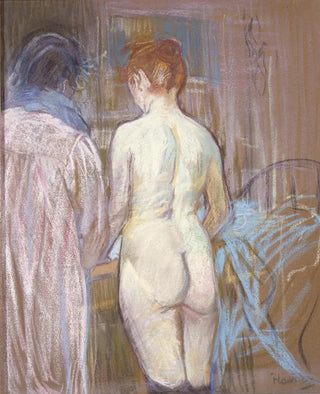Art print | Prostitutes - Henri de Toulouse-Lautrec Source: Reproduction | Prostituées - Henri de Toulouse-Lautrec


View from behind

Frame (optional)
Prostituées Art print - Henri de Toulouse-Lautrec – Engaging Introduction
In the vibrant world of art, certain works stand out for their boldness and their ability to capture the essence of a particular era. "Prostituées" by Henri de Toulouse-Lautrec is undoubtedly one of these iconic pieces. Painted at the end of the 19th century, this artwork immerses the viewer in bohemian Paris, where nightlife blends with raw, unvarnished realism. Toulouse-Lautrec, with his unique perspective, depicts not only the figures of these often marginalized women but also the lively and sometimes tragic atmosphere of their lives. This canvas invites a deep reflection on the human condition and the social dynamics of its time.
Style and uniqueness of the work
Toulouse-Lautrec's style is characterized by bold chromatic choices and a flowing line that transcend the artistic conventions of his era. "Prostituées" is a perfect example of this innovative approach. The vivid colors and stylized forms serve a visual narrative that leaves no one indifferent. The artist plays with shadows and light to highlight the features of the characters, creating an atmosphere that is both intimate and unsettling. The faces of the women, vulnerable yet powerful, tell stories of despair and resilience. This duality is what makes the work so captivating, as it goes beyond simple representation to offer a true immersion into the complex universe of its subjects.
The artist and his influence
Henri de Toulouse-Lautrec, an emblematic figure of the post-impressionist movement, established himself as one of the most influential artists of his time. His journey, marked by personal and physical challenges, fostered a deeply human artistic vision. Toulouse-Lautrec captured the essence of Parisian life, from cabarets to salons, and bustling streets. His work paved the way for many artists who, after him, explored the depiction of everyday life with a new sensitivity. By focusing on often neglected subjects, such as prostitutes, he also contributed to a broader reflection on the role of women in society.

Matte finish

View from behind

Frame (optional)
Prostituées Art print - Henri de Toulouse-Lautrec – Engaging Introduction
In the vibrant world of art, certain works stand out for their boldness and their ability to capture the essence of a particular era. "Prostituées" by Henri de Toulouse-Lautrec is undoubtedly one of these iconic pieces. Painted at the end of the 19th century, this artwork immerses the viewer in bohemian Paris, where nightlife blends with raw, unvarnished realism. Toulouse-Lautrec, with his unique perspective, depicts not only the figures of these often marginalized women but also the lively and sometimes tragic atmosphere of their lives. This canvas invites a deep reflection on the human condition and the social dynamics of its time.
Style and uniqueness of the work
Toulouse-Lautrec's style is characterized by bold chromatic choices and a flowing line that transcend the artistic conventions of his era. "Prostituées" is a perfect example of this innovative approach. The vivid colors and stylized forms serve a visual narrative that leaves no one indifferent. The artist plays with shadows and light to highlight the features of the characters, creating an atmosphere that is both intimate and unsettling. The faces of the women, vulnerable yet powerful, tell stories of despair and resilience. This duality is what makes the work so captivating, as it goes beyond simple representation to offer a true immersion into the complex universe of its subjects.
The artist and his influence
Henri de Toulouse-Lautrec, an emblematic figure of the post-impressionist movement, established himself as one of the most influential artists of his time. His journey, marked by personal and physical challenges, fostered a deeply human artistic vision. Toulouse-Lautrec captured the essence of Parisian life, from cabarets to salons, and bustling streets. His work paved the way for many artists who, after him, explored the depiction of everyday life with a new sensitivity. By focusing on often neglected subjects, such as prostitutes, he also contributed to a broader reflection on the role of women in society.






